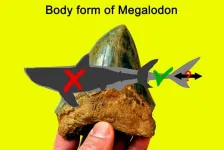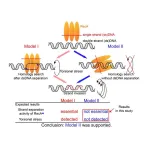(Press-News.org) CHICAGO — A new scientific study shows that the prehistoric gigantic shark, Megalodon or megatooth shark, which lived roughly 15-3.6 million years ago nearly worldwide, was a more slender shark than previous studies have suggested.
Formally called Otodus megalodon, it is typically portrayed as a super-sized, monstrous shark in novels and sci-fi films, including “The Meg.” Previous studies suggest the shark likely reached lengths of at least 50 to 65 feet (15 to 20 meters). However, O. megalodon is largely known only from its teeth and vertebrae in the fossil record. Thus, the modern great white shark (Carcharodon carcharias) has traditionally been used as a model for the body form of O. megalodon in previous studies.
The new study published in the journal “Palaeontologia Electronica,” however, illuminates that O. megalodon had a body form that was more elongated than the modern great white shark. “The remarkably simple evidence that O. megalodon had a more slender body than the great white shark was hidden in plain sight,” said Kenshu Shimada, DePaul University paleobiology professor, a co-leader and the senior author of the new study.
A previously described, incomplete set of fossil vertebrae from an O. megalodon individual was reported to be 11.1 m in total combined vertebral length. However, the exact same fossil individual was estimated to be only 9.2 m in total length, including the head, in yet another previous study extrapolated from the quantitative relationship between the diameters of the largest vertebrae and body lengths measured from multiple modern great white sharks. “It was a ‘eureka-moment’ when our research team realized the discrepancy between the two previously published lengths for the same Megalodon specimen,” added Shimada.
“The new study strongly suggests that the body form of O. megalodon was not merely a larger version of the modern great white shark,” noted the other co-leader Phillip Sternes, who studied with Shimada and earned his master’s degree from DePaul. Sternes, the first author of the study, is now a Ph.D. candidate at the University of California, Riverside.
“Even though it remains uncertain exactly how long the body of O. megalodon was elongated relative to the great white shark, this new finding marks a major scientific breakthrough in the quest to decipher what Megalodon looked like,” described Sternes.
The research team of the new study consists of 26 shark experts including Sternes and Shimada, representing 29 academic institutions around the globe, including the U.K., Austria, Italy, Japan, Mexico, Brazil, France and Australia, as well as the U.S. The international team also includes Jake Wood, who was also one of Shimada’s master’s students.
“Moving forward, any meaningful discussion about the body form of O. megalodon would require the discovery of at least one complete, or nearly complete, skeleton of the species in the fossil record,” noted Wood.
“Despite the major scientific advancement in our new study, the fact that we still don’t know exactly how O. megalodon looked keeps our imagination going,” Shimada said. “The continued mystery like this makes paleontology, the study of prehistoric life, a fascinating and exciting scientific field.”
The new study, “White shark comparison reveals a slender body for the extinct megatooth shark, Otodus megalodon (Lamniformes: Otodontidae),” will appear in the forthcoming issue of Palaeontologia Electronica, which will be freely available online at https://doi.org/10.26879/1345. It is authored by: Phillip Sternes, Patrick Jambura, Julia Türtscher, Jürgen Kriwet, Mikael Siversson, Iris Feichtinger, Gavin Naylor, Adam Summers, John Maisey, Taketeru Tomita, Joshua Moyer, Timothy Higham, João Paulo da Silva, Hugo Bornatowski, Douglas Long, Victor Perez, Alberto Collareta, Charlie Underwood, David Ward, Romain Vullo, Gerardo González-Barba, Harry Maisch IV, Michael Griffiths, Martin Becker, Jake Wood, and Kenshu Shimada. This work was partially supported by a U.S. National Science Foundation grant (Award Number 1830858) and DePaul University’s University Research Council Competitive Research Grant awarded to Kenshu Shimada.
###
END
Slender shark: Study finds Megalodon was not like a gigantic great white shark
Kenshu Shimada at DePaul University co-authors research with 26 shark experts
2024-01-22
ELSE PRESS RELEASES FROM THIS DATE:
New criteria for sepsis in children based on organ dysfunction
2024-01-21
Clinician-scientists from Ann & Robert H. Lurie Children’s Hospital of Chicago were among a diverse, international group of experts tasked by the Society of Critical Care Medicine (SCCM) with developing and validating new data-based criteria for sepsis in children. Sepsis is a major public heath burden, claiming the lives of over 3.3 million children worldwide every year. The new pediatric sepsis criteria – called the Phoenix criteria – follow the paradigm shift in the recent adult criteria that define sepsis as severe ...
Development and validation of the Phoenix criteria for pediatric sepsis and septic shock
2024-01-21
About The Study: In this international, multicenter, retrospective cohort study including more than 3.6 million pediatric encounters, a novel score, the Phoenix Sepsis Score, was derived and validated to predict mortality in children with suspected or confirmed infection. The new criteria for pediatric sepsis and septic shock based on the score performed better than existing organ dysfunction scores and the International Pediatric Sepsis Consensus Conference criteria.
Authors: Tellen D. Bennett, M.D., M.S., of the University of Colorado School of Medicine and Children’s Hospital Colorado in Aurora, is the corresponding author.
To access the ...
International consensus criteria for pediatric sepsis and septic shock
2024-01-21
About The Study: The Phoenix sepsis criteria for sepsis and septic shock in children were derived and validated by the international Society of Critical Care Medicine Pediatric Sepsis Definition Task Force using a large international database and survey, systematic review and meta-analysis, and modified Delphi consensus approach. A Phoenix Sepsis Score of at least 2 identified potentially life-threatening organ dysfunction in children younger than 18 years with infection, and its use has the potential to improve clinical care, epidemiological assessment, and research in pediatric sepsis and septic shock around the world.
Authors: R. Scott ...
CU researchers unveil modernized criteria for pediatric sepsis and septic shock
2024-01-21
An international research team led by Tell Bennett, MD, MS, professor of biomedical informatics and pediatric critical care at the University of Colorado School of Medicine, released new diagnostic criteria for sepsis in children this week, marking the first update to the pediatric sepsis definition in nearly two decades.
The updated criteria, presented at the 2024 Critical Care Congress of the Society for Critical Care Medicine (SCCM), will be utilized ...
A computerized decision support system significantly reduces high-risk drug combinations in Intensive Care patients
2024-01-21
A recent multicentre study led by Amsterdam UMC and conducted in nine Dutch Intensive Care Units (ICUs) has shown that tailoring a computerised decision support system (CDSS) to the ICU environment significantly reduced the number of high-risk drug combinations administered to ICU patients. It also improved monitoring ICU patients when avoiding such combinations was not possible, and reduced the length of patients’ stay in the ICU. This study is published today in The Lancet.
"Not more, but fewer and more relevant alerts by a CDSS make such a system more valuable for healthcare providers and patients," says Amsterdam ...
Scientists unravel key steps in the road to DNA repair
2024-01-20
Tokyo, Japan – Researchers from Tokyo Metropolitan University have been studying DNA repair by homologous recombination, where the RecA protein repairs breaks in double-stranded DNA by incorporating a dangling single-strand end into intact double strands, and repairing the break based on the undamaged sequence. They discovered that RecA finds where to put the single strand into the double helix without unwinding it by even a single turn. Their findings promise new directions in cancer research.
Homologous recombination (HR) is a ubiquitous biochemical process shared across all living things, including animals, plants, fungi, and bacteria. As we go about our daily ...
Study identifies new PD-1 immune checkpoint mechanism promoting merkel cell carcinoma growth
2024-01-19
Programmed cell death 1 (PD-1) is an important target for immune checkpoint inhibitor therapies that block its signaling and boost T-cell activity. PD-1 inhibitors have been approved for treating various types of cancer.
But PD-1 functions can vary between different cell and cancer types, either promoting or suppressing disease progression. Merkel cell carcinoma (MCC), a rare and aggressive form of skin cancer, responds well to immune checkpoint inhibitor therapy. However, it was previously unknown if MCC cells express PD-1 themselves, and unclear how exactly cancer cell-intrinsic ...
Vanderbilt chemist Ben Brown awarded $2.375M to develop nonaddictive painkillers with AI
2024-01-19
When Ben Brown, research assistant professor of chemistry, thinks about the opioid epidemic, he views the problem on a molecular level. Painkillers used legitimately in medicine, such as oxycodone, are highly addictive, but better understanding of how their molecules interact with proteins in the body could lead to the formulation of nonaddictive alternatives, he said.
In May, the National Institute on Drug Abuse awarded Brown $1.5 million over five years to further his work in this area. Brown, faculty affiliate of the Vanderbilt Center for Addiction Research and the Center for Applied Artificial Intelligence in Protein Dynamics, is developing artificial intelligence that ...
National champion tree program finds new home
2024-01-19
The National Champion Tree Program started 83 years ago at American Forests to discover the largest, living trees in the United States. Now, the program is moving from the organization’s headquarters to a new home in the School of Natural Resources at the University of Tennessee Institute of Agriculture (UTIA).
American Forests launched the Champion Tree Program in 1940. Its vision included establishing a nationwide laboratory for the study of forestry and trees. Being housed at Tennessee’s 1862 public land-grant university will advance the program’s understanding of big trees. “The National Champion Tree Program moving to UTIA means it can continue protecting ...
New AEM study evaluates potential disparities in restraint use in the emergency department at a minority-serving safety-net hospital
2024-01-19
Des Plaines, IL — A new study that contributes additional data to a growing body of evidence demonstrating disparities in restraint use in the emergency department (ED) has been published in the January issue of Academic Emergency Medicine (AEM), the peer-reviewed journal of the Society for Academic Emergency Medicine (SAEM). The study, titled Disparities in use of physical restraints at an urban, minority-serving hospital emergency department evaluates the association between race/ethnicity and the use of restraints in an ED population ...
LAST 30 PRESS RELEASES:
Numbers in our sights affect how we perceive space
SIMJ announces global collaborative book project in commemoration of its 75th anniversary
Air pollution exposure and birth weight
Obstructive sleep apnea risk and mental health conditions among older adults
How talking slows eye movements behind the wheel
The Ceramic Society of Japan’s Oxoate Ceramics Research Association launches new international book project
Heart-brain connection: international study reveals the role of the vagus nerve in keeping the heart young
Researchers identify Rb1 as a predictive biomarker for a new therapeutic strategy in some breast cancers
Survey reveals ethical gaps slowing AI adoption in pediatric surgery
Stimulant ADHD medications work differently than thought
AI overestimates how smart people are, according to HSE economists
HSE researchers create genome-wide map of quadruplexes
Scientists boost cell "powerhouses" to burn more calories
Automatic label checking: The missing step in making reliable medical AI
Low daily alcohol intake linked to 50% heightened mouth cancer risk in India
American Meteorological Society announces Rick Spinrad as 2026 President-Elect
Biomass-based carbon capture spotlighted in newly released global climate webinar recording
Illuminating invisible nano pollutants: advanced bioimaging tracks the full journey of emerging nanoscale contaminants in living systems
How does age affect recovery from spinal cord injury?
Novel AI tool offers prognosis for patients with head and neck cancer
Fathers’ microplastic exposure tied to their children’s metabolic problems
Research validates laboratory model for studying high-grade serous ovarian cancer
SIR 2026 delivers transformative breakthroughs in minimally invasive medicine to improve patient care
Stem Cell Reports most downloaded papers of 2025 highlight the breadth and impact of stem cell research
Oxford-led study estimates NHS spends around 3% of its primary and secondary care budget on the health impacts of heat and cold in England
A researcher’s long quest leads to a smart composite breakthrough
Urban wild bees act as “microbial sensors” of city health.
New study finds where you live affects recovery after a hip fracture
Forecasting the impact of fully automated vehicle adoption on US road traffic injuries
Alcohol-related hospitalizations from 2016 to 2022
[Press-News.org] Slender shark: Study finds Megalodon was not like a gigantic great white sharkKenshu Shimada at DePaul University co-authors research with 26 shark experts



